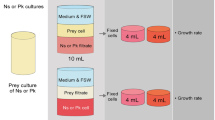Abstract
Cultures of the marine diatom Coscinodiscus eccentricus Ehrenberg were grown at four salinities, namely 20, 25, 30 and 35%. The changes in the carbohydrate, protein, silicon and pigment concentrations of the cells were studied throughout the growth cycles in these salinities. The carbohydrate content, expressed as a percentage of the cell dry weight, increased in all cultures during the lag and early log phases. It later fell, sharply at first, as it was used up faster than it was produced. It was not stored during the stationary phase. The protein percentage composition built up to a peak at different stages during the exponential or stationary growth stages, depending on the salinity, but was later respired. The silicon percentage of the dry weight usually decreased during the log phase, as the cells were dividing before becoming fully silicified, and remained low in the stationary phase due to an increase in the volume of the cells. The changes in the frustular thickness were also calculated. The values ranged from 0.24 to 0.35 μm (at the beginning and end of the experiments) to 0.15 μm during the log growth phase. The pigment content was always low. The lipid composition of the cells was calculated by difference. It was usually low during the exponential growth phase, but was accumulated during the stationary phase. The point at which this accumulation began was associated with the time when protein respiration started.
Similar content being viewed by others
Literature Cited
Antia, N.J., C.D. McAllister, T.R. Parsons, K. Stephens and J.D.H. Strickland: Further measurements of primary production using a largevolume plastic sphere. Limnol. Oceanogr. 8, 166–183 (1963)
Banoub, M.W. and J.D. Burton: The winter distribution of silicate in Southampton Water. J. Cons. int. Explor. Mer 32, 201–208 (1968)
Berland, B.R., D.J. Bonin, R.A. Daumas, P.L. Laborde et S.Y. Maestrini: Variations du comportement physiologique de l'algue Monallantus salina (xanthophycée) en culture. Mar. Biol. 7, 82–92 (1970)
Chow, D.T-W. and R.J. Robinson: Forms of silicate available for colorimetric determinations. Analyt. Chem. 25, 646–648 (1953)
Collyer, D.M. and G.E. Fogg: Studies on fat accumulation by algae. J. exp. Bot. 6, 256–275 (1955)
Coombs, J., W.M. Darley, O. Holm-Hansen and B.E. Volcani: Studies on the biochemistry and fine structure of silica shell formation in diatoms. Chemical composition of Navicula pelliculosa during silicon-starvation synchrony. Pl. Physiol., Lancaster 42, 1601–1606 (1967)
Einsele, W. und J. Grim: Über die Kieselsäuregehalt planktischer Diatomeen und dessen Bedeutung für einige Fragen ihrer Ökologie. Z. Bot. 32, 545–590 (1938)
Guillard, R.R.L.: Organic sources of nitrogen for marine centric diatoms. In: Symposium on marine microbiology, pp 93–104. Ed. by C.H. Oppenheimer. Springfield, Illinois: C.C. Thomas 1963
Handa, N.: Carbohydrate metabolism in the marine diatom Skeletonema costatum. Mar. Biol. 4, 208–214 (1969)
Jørgensen, E.G.: Variations in the silica content of diatoms. Physiologia Pl. 8, 840–845 (1955)
Lewin, J.C.: Silicon metabolism in diatoms. IV. Growth and frustule formation in Navicula pelliculosa. Can. J. Microbiol. 3, 427–433 (1957)
—: Silification. In: Physiology and biochemistry of algae, pp 457–465 Ed. by. R.A. Lewin. London: Academic Press 1962
— and R.R.L. Guillard: Diatoms. A. Rev. Microbiol. 17, 373–414 (1963)
—, R.A. Lewin and D.E. Philpott: Observations on Phaeodactylum tricornutum. J. gen. Microbiol. 18, 418–426 (1958)
Lund, J.W.G.: Studies on Asterionella formosa Hass. II. Nutrient depletion and the spring maximum. J. Ecol. 38, 15–35 (1950)
Marshall, S.M. and A.P. Orr: Carbohydrate as a measure of phytoplankton. J. mar. biol. Ass. U.K. 42, 511–519 (1962)
Mullin, J.B. and J.P. Riley: The colorimetric determination of silicate with special reference to the sea and natural waters. Analytica chim. Acta 12, 162–176 (1955)
Myklestad, S.: Production of carbohydrate by marine planktonic diatoms. I. Comparison of nine different species in culture. J. exp. mar. Biol. Ecol. 15, 261–274 (1974)
Parsons, T.R., K. Stephens and J.D.H. Strickland: On the chemical composition of eleven species of marine phytoplankters. J. Fish. Res. Bd Can. 18, 1001–1016 (1961)
Pugh, P.R.: Studies on the sinking rates of Coscinodiscus eccentricus Ehrenberg, with special reference to changes in its biochemical composition, 245 pp. Ph.D, Thesis submitted to the University of Southampton 1969
—: Changes in the fatty acid composition of Coscinodescus eccentricus with culture-age and salinity. Mar. Biol. 11, 118–124 (1971)
Ricketts, T.R.: On the chemical composition of some unicellular algae. Phytochem. 5, 67–76 (1966)
Strickland, J.D.H., O. Holm-Hansen, R.W. Eppley and R.J. Linn: The use of a deep tank in plankton ecology. I. Studies of the growth and composition of phytoplankton crops at low nutrient levels. Limnol. Oceanogr. 14, 23–34 (1969)
— and T.R. Parsons: A manual of sea water analysis (2nd ed., revised). Bull. Fish. Res. Bd Can. 125, 1–203 (1965)
Thomas, P. et R. Dumas: Contribution a l'etude de Dunaliella salina en cultures bacteriennes: nutrition et composition. Téthys 2, 19–28 (1970)
UNESCO: Determination of photosynthetic pigments in sea water. Monogr. oceanogrl Methodol. (UNESCO) 1, 1–69 (1966)
Werner, D.: Die Kieselsäure im Stoffwechsel von Cyclotella cryptica Reiman, Lewin und Guillard. Arch. Mikrobiol. 55, 278–308 (1966)
—: Productivity studies on diatom cultures. Helgoländer wiss. Meeresunters. 20, 97–103 (1970)
Author information
Authors and Affiliations
Additional information
Communicated by J.H.S. Blaxter, Oban
Rights and permissions
About this article
Cite this article
Pugh, P.R. Variations in the biochemical composition of the diatom Coscinodiscus eccentricus with culture age and salinity. Marine Biology 33, 195–205 (1975). https://doi.org/10.1007/BF00390923
Accepted:
Issue Date:
DOI: https://doi.org/10.1007/BF00390923




